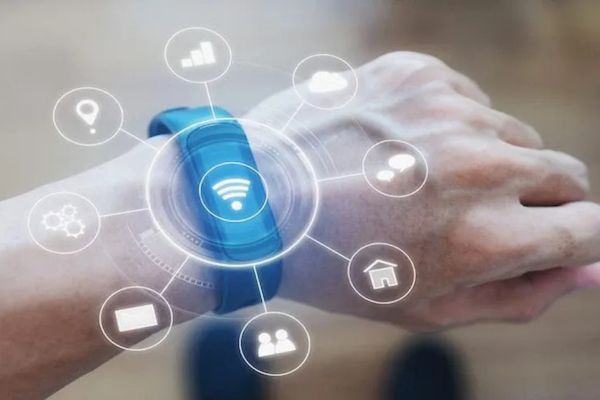The global wearable technology market is anticipated to grow significantly, from a valuation of US$ 218.27 billion in 2024 and projected to reach US$ 885.65 billion by 2033. This growth represents a robust CAGR of 16.84% during the forecast period from 2025 to 2033.

Wearable technology is experiencing rapid growth and is becoming increasingly integrated into various facets of daily life. This surge in the wearable technology market is largely driven by heightened health awareness, advancements in connectivity, and the incorporation of user-friendly applications. The most prevalent connectivity technologies in the wearable sector are Bluetooth Low Energy (BLE) and Near Field Communication (NFC).
These technologies facilitate wireless payments and contactless interactions, which are reported to be utilized more frequently on wearables than on standard smartphones. This trend indicates a growing adoption of wearable payment solutions, reflecting a shift in consumer behavior towards more convenient and efficient transaction methods.
Wearable Technology Market Key Takeaways
- By Product Type, Smartwatches hold a significant position in the wearable technology market, commanding over 36.65% of the market share.
- In terms of connectivity, Bluetooth Low Energy (BLE) stands out with an impressive market share of over 46.36% in the wearable technology sector.
- When examining applications, the consumer electronics segment has captured more than 17.54% of the wearable technology market.
- Regarding end-users, personal-use applications dominate the market, representing over 46.61% of the wearable technology market share.
Regional Analysis
Rapid Growth in the Asia Pacific Wearable Technology Market
The Asia Pacific region has emerged as the fastest-growing area in the wearable technology market, experiencing an impressive CAGR of 15% projected until 2033. This rapid expansion is driven by several key factors that position the region for sustained growth.
- Surge in Wearable Shipments in China: China has recorded a remarkable 20% year-over-year increase in wearable shipments. This surge is largely attributed to leading tech companies like Xiaomi and Huawei, which provide affordable yet feature-rich devices. Their ability to deliver high-quality wearables at competitive prices has significantly boosted consumer adoption.
- Strategic Importance for Global Brands: As a rapidly evolving market, Asia Pacific represents a strategic battleground for global brands aiming to secure long-term revenue and market share growth. The combination of a young, tech-oriented population and innovative product offerings creates significant opportunities for companies looking to establish a strong presence in this dynamic region.
- Young Demographic Driving Demand: A critical factor contributing to the Asia Pacific’s growth is its young demographic, with over 40% of consumers in the region being under 30. This youthful population is particularly inclined toward adopting cutting-edge wearables, which cater to their tech-savvy lifestyle and desire for the latest innovations.
North America’s Dominance in the Wearable Technology Market
Currently, North America stands as the market leader in wearable technology, commanding over 38% of the global market share. This region’s advancements and consumer engagement have positioned it at the forefront of the industry.
- Continuous Innovation: The U.S. market is characterized by a relentless pursuit of innovation. Companies are consistently introducing advanced features and technologies, keeping consumers engaged and driving competition within the sector.
- Robust Purchasing Power: American consumers possess significant purchasing power, allowing them to invest in high-quality wearable devices. This financial capability encourages manufacturers to offer a diverse range of products tailored to various needs and preferences.
- Rapid Feature Adoption: The U.S. market exhibits a trend of quick adoption of new features, whether in health tracking, connectivity, or user interface design. This agility enables American companies to set trends that ripple through the global market.
European Wearable Technology Market
Europe boasts a matured wearable technology market, accounting for nearly 25% of worldwide shipments in 2023. This significant contribution highlights the region’s advanced infrastructure and increasing consumer interest in wearable devices.
- Robust Healthcare Systems: The well-established healthcare frameworks in many European nations facilitate the integration of wearable technology into everyday health management, encouraging users to leverage these devices for better health outcomes.
- Employer-Backed Health Incentives: Many employers across Europe are promoting health and wellness by offering incentives for employees to use wearables. These incentives may include discounts on insurance premiums or rewards for achieving fitness milestones, further motivating adoption.
- Trust Through Privacy Regulations: A significant aspect of the European market is its commitment to stringent data privacy regulations. The implementation of the General Data Protection Regulation (GDPR) and other local laws ensures that users’ personal information is protected, fostering a sense of security among consumers.
Top Trends Escalating the Wearable Technology Market
Integration of AI-Driven Analytics for Personalized Health Insights: The incorporation of AI-driven analytics is transforming how users interact with their wearable devices. By leveraging machine learning algorithms, wearables can analyze vast amounts of health data to provide personalized insights tailored to individual users.
Expansion of Smartwatch Functionalities: Smartwatches are evolving beyond their original purpose of fitness tracking. Today, they offer a broad range of functionalities that integrate seamlessly into users’ daily lives. Features now include advanced health monitoring (such as ECG and blood oxygen levels), mobile payment capabilities, and integration with smart home devices.
Emergence of Subscription-Based Services: The introduction of subscription-based services marks a significant shift in the wearable technology landscape. These services often provide users access to advanced health monitoring capabilities, personalized coaching, and comprehensive health reports for a recurring fee.
Advancements in Sensor Technology and Data Analytics Capabilities: Recent advancements in sensor technology have significantly improved the functionality of wearable devices. Modern wearables are equipped with sophisticated sensors that can monitor a wide range of physiological parameters, including heart rate variability, sleep quality, and even hydration levels. Coupled with enhanced data analytics capabilities, these sensors enable more accurate readings and better data interpretation.
Increased Demand for Personalized User Experiences: As consumers become more health-conscious and tech-savvy, there is an increased demand for personalized user experiences in wearable devices. This trend has led manufacturers to focus on customization options, such as interchangeable bands, personalized watch faces, and customizable health alerts.
Wearable Technology Market Segmentation
By Product Type
Smartwatches have established themselves as a significant player in the wearable technology market. This substantial share reflects the growing popularity and diverse functionality of smartwatches, appealing to a wide range of end users. Many active individuals use smartwatches to track their workouts, monitor heart rates, and set fitness goals.
By Connectivity
Bluetooth Low Energy (BLE) has emerged as a dominant force in the wearable technology market. This technology was introduced as part of the Bluetooth 4.0 core specification, marking a significant advancement in wireless communication. A key milestone for BLE was the standardization of its energy-saving attributes, which have made it particularly appealing for a wide range of applications.
By Application
The consumer electronics segment has successfully captured over 17.54% of the market share within the wearable technology landscape. This significant share highlights the growing integration of wearable devices into everyday consumer products, driven by their appeal to users seeking hands-free solutions that seamlessly combine entertainment, fitness tracking, and communication tools.
By End Users
Personal-use applications have established a significant presence in the wearable technology market. This remarkable figure underscores their importance and widespread adoption among consumers seeking practical solutions for daily life. The success of personal-use applications can be attributed to their ability to cater to various everyday conveniences that enhance the user experience.
Wearable Technology Market Recent Developments
- Meta’s Upcoming Wearables: In February 2025, Meta plans to launch “half a dozen more” wearable devices. These products may include different styles of glasses, similar to the Ray-Ban smart glasses available in various designs such as “Wayfarer,” “Skyler,” and “Headliner.”
- Three’s eSIM Technology: In January 2025, Three announced the introduction of its eSIM wearable technology, allowing Apple smartwatch owners to take calls, send messages, and use data directly from their smartwatch, even without their mobile device nearby.
- BOULT’s Trail Pro Smartwatch: In January 2025, BOULT launched its much-anticipated Trail Pro Smartwatch. This device features cutting-edge technology aimed at enhancing various aspects of daily life, combining premium design, advanced health tracking, seamless connectivity, and powerful performance.
- Novosound’s Miniaturized Ultrasound Technology: In January 2025, Glasgow-based Novosound unveiled a breakthrough in miniaturized ultrasound technology, which enables real-time, continuous blood pressure monitoring in a sleek, wearable format.
- Wearable Devices’ Mudra Link: In January 2025, Wearable Devices announced the general availability of its Mudra Link, the first neural wristband compatible with Android, macOS, and Windows devices.
- VIV Health’s Smart Ring: In January 2025, VIV Health introduced the VIV Ring, a smart ring designed for health monitoring and sleep enhancement using generative sleep aid sound technology.
Download Sample Copy: https://www.astuteanalytica.com/request-sample/wearable-technology-market
Top Players in the Wearable Technology Market
- Adidas AG
- Apple Inc.
- Fitbit, Inc.
- Fossil Group
- FUJITSU
- Garmin Ltd.
- Huawei Technologies Co. Ltd
- LG Electronics, Inc.
- Nike Inc.
- Samsung Electronics Co., Ltd.
- Seiko Epson Corporation
- Sony Corporation
- Vuzix
- Xiaomi Corporation
- Zepp Health Corporation
- Other Prominent Players
Market Segmentation Overview:
By Product Type
- Smart Glasses
- Smart Watches
- Smart Jewelry
- Smart Rings
- Smart Bracelets
- Others
- Smart Clothing & Footwear
- Wrist Bands
- Fitness Trackers
- Head Mounted Display
- Others
By Connectivity
- Near Field Communication (NFC)
- Bluetooth Low Energy (BLE)
- Wi-Fi Network
- Others
By Application
- Consumer Electronics
- Fitness & Wellness
- Fashion & Lifestyle
- Safety & Security
- Healthcare & Medical
- Others
By End User
- Personal
- Commercial
- Retail
- Education
- Entertainment
- Enterprise
- Others
- Defense
- Industrial
- Oil & Gas
- Chemicals & Pharmaceuticals
- Construction
- Others
- Others
By Distribution Channel
- eMarketplaces
- Offline
- Supermarket/ Hypermarket
- Brand Retail Stores
By Geography
- North America
- Europe
- Asia-Pacific
- Latin America
- Middle East and Africa
Source: https://www.astuteanalytica.com/industry-report/wearable-technology-market

















